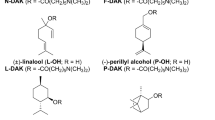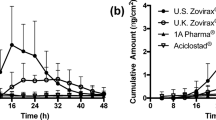Abstract
Purpose. A theoretical design of percutaneous penetration enhancement in which prodrug derivation and enhancer application are combined is proposed based on the skin diffusion model and it is experimentally verified.
Methods. Employing acyclovir as a model drug, the hypothesis was tested by synthesis of its prodrugs and evaluation of their in vitro permeation in the rat skin, with or without a penetration enhancer, 1-geranylazacycloheptan-2-one(GACH).
Results. Among five acyclovir prodrugs, those with higher lipophilicit-ies (propionate, butyrate, valerate, and hexanoate prodrugs) showed greater skin penetration than those of hydrophilic prodrugs (acetate), when administered in combination with GACH. Furthermore, the observed enhancement ratios were in good agreement with those predicted by theoretical consideration.
Conclusions. Thus, skin permeation of prodrugs applied with an enhancer can be predicted and optimized by model analysis.
Similar content being viewed by others
REFERENCES
A. C. Williams and B. W. Barry. The enhancement index concept applied to terpens penetration enhancers for human skin and model lipophilic (oestradiol) and hydrophilic (5-fluorouracil) drugs. Int. J. Pharm. 74:157–168 (1991).
K. B. Sloan. Prodrugs: Topical and Ocular Drug Delivery, Marcel Dekker Inc., New York, 1992.
P. G. Green, R. S. Hinz, A. Kim, F. C. Szoka, and R. H. Guy. Iontophoretic delivery of a series of tripeptides across the skin in vitro. Pharm. Res. 8:1121–1127 (1991).
W. M. Shannon, L. Westbrook, W. I. Higuchi, K. Sugibayashi, D. C. Baker, S. D. Kumar, J. L. Fox, G. L. Flynn, N. F. H. Ho, and R. Vaidyanathan. Influence of 1-dodecylazacycloheptan-2-one (Azone) on the topical therapy of cutaneous herpes simplex virus type 1 infection in hairless mice with 2′,3′-di-o-acetyl-9-β-d-arabinofuranosyladenine and 5′-o-valeryl-9-β-d-arabinofuranosyladenine. J. Pharm. Sci. 74:1157–1161 (1985).
H. Okamoto, F. Yamashita, K. Saito, and M. Hashida. Analysis of drug penetration through the skin by the two layer skin diffusion model. Pharm. Res. 6:931–937 (1989).
A. H. Ghanem, H. Mahmoud, W. I. Higuchi, U. D. Rohr, S. Borsadia, P. Liu, J. L. Fox, and W. R. Good. The effects of ethanol on the transport of β-estradiol and other permeants in hairless mouse skin. II. A new quantitative approach. J. Controlled Release. 6:75–83 (1987).
F. Yamashita, T. Yoshioka, Y. Koyama, H. Okamoto, H. Sezaki, and M. Hashida. Analysis of skin penetration enhancement based on a two-layer skin diffusion model with polar and nonpolar routes in the stratum corneum: Dose-dependent effect of 1-geranylazacycloheptan-2-one on drugs with different lipophilicities. Biol. Pharm. Bull. 16:690–697 (1993).
Y. Yano, K. Yamaoka, and H. Tanaka. A nonlinear least squares program, MULTI(FILT), based on fast inverse Laplace transform for microcomputers. Chem. Pharm. Bull. 37:1035–1038 (1989).
A. Leo, C. Hansch, and D. Elkins. Partition coefficients and their uses. Chem. Rev. 71:525 (1971).
C. Ackermann and G. L. Flynn. Ether-water partitioning and permeability through nude mouse skin in vitro. I Urea, thiourea, glycerol and glucose. Int. J. Pharm. 36:61–66 (1987).
F. Yamashita, H. Bando, Y. Koyama, S. Kitagawa, Y. Takakura, and M. Hashida. In vivo and in vitro analysis of skin penetration enhancement based on a two-layer diffusion model with polar and nonpolar routes in the stratum corneum. Pharm. Res. 11:185–191 (1994).
H. Bundgaard, E. Jensen, and E. Falch. Water-soluble, solution-stable, and biolabile n-substituted (aminomethyl) benzoate ester prodrugs of acyclovir. Pharm. Res. 8:1087–1093 (1990).
H. Bando, F. Yamashita, Y. Takakura, and M. Hashida. Skin penetration enhancement of acyclovir by prodrug-enhancer combination. Biol. Pharm. Bull. 17:1141–1143 (1994).
Z. Shao, G. B. Park, R. Krishnamoorthy, and A. K. Mitra. The physicochemical properties, plasma enzymatic hydrolysis, and nasal absorption of acyclovir and its 2′-ester prodrugs. Pharm. Res. 11:237–242 (1994).
P. Liu, W. I. Higuchi, A. H. Ghanem, and W. R. Good. Transport of b-estradiol in Freshly Excised Human Skin in Vitro: Diffusion and Metabolism in Each Skin Layer. Pharm. Res. 11:1777–1784 (1994).
Author information
Authors and Affiliations
Rights and permissions
About this article
Cite this article
Bando, H., Takagi, T., Yamashita, F. et al. Theoretical Design of Prodrug-Enhancer Combination Based on a Skin Diffusion Model: Prediction of Permeation of Acyclovir Prodrugs Treated with l-Geranylazacycloheptan-2-one. Pharm Res 13, 427–432 (1996). https://doi.org/10.1023/A:1016000827719
Issue Date:
DOI: https://doi.org/10.1023/A:1016000827719




